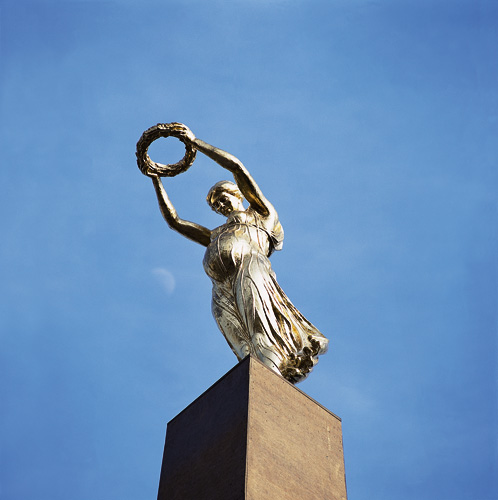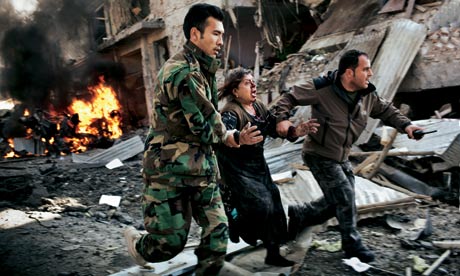MOVED TO
WORKBYART.TUMBLR.COM
thanks
Work By Art
A blog dedicated to creative solutions to changing the world. Highlighting and examining new and old work in social practice art, public art, design, urban planning, and architecture. Art that does something for you and I.
Fred Wilson's proposed project for the Indianapolis, IN Soldiers and Sailors Monument has been officially dropped.
Wilson had scanned the recently freed slave in the monument and was going to recast the downtrodden slave (reaching up for help from lady liberty) in an upright position holding a flag of African nations. This repurposing and tweaking is critiquing old representations of the African Americans as helpless passive observers in their own freedom, and representation that is completely untrue. Wilson's new monument would have created a new image of a powerful figure of African American pride.
The work confronts public monuments' tendency to outlast their relevancy or cultural paradigm. Like statues to dictators (below). Unfortunately, this monument is left with racist imagery, and will not be given a contemporary update.
definitely read more here and at MAN
also, if you are interested in the tendency for monuments to outlast their relevancy, watch this long but good lecture here and then here.
Wilson had scanned the recently freed slave in the monument and was going to recast the downtrodden slave (reaching up for help from lady liberty) in an upright position holding a flag of African nations. This repurposing and tweaking is critiquing old representations of the African Americans as helpless passive observers in their own freedom, and representation that is completely untrue. Wilson's new monument would have created a new image of a powerful figure of African American pride.
The work confronts public monuments' tendency to outlast their relevancy or cultural paradigm. Like statues to dictators (below). Unfortunately, this monument is left with racist imagery, and will not be given a contemporary update.
photo by Jerome Delay
definitely read more here and at MAN
also, if you are interested in the tendency for monuments to outlast their relevancy, watch this long but good lecture here and then here.
A feminist reaction to public monuments, definitely worth reading more:
Among the projects that represent Iveković’s feminist position, Lady Rosa of Luxembourg is her most public statement. In 1998, when the artist was invited to participate in Manifesta, a biennial exhibition of contemporary art held that year in Luxembourg, she proposed a civic intervention, titled Pregnant Memory, that would involve removing the gilded, larger-than-life neoclassical Nike (the allegorical female figure of victory) from the war memorial known as Gëlle Fra (Golden lady): the figure would have been taken from the top of its obelisk in Constitution Square, in the center of the capital city, and installed on the premises of a shelter for abused women. Gëlle Fra was designed in 1923 in memory of the volunteers who fought with the Allies in World War I. In 1940, during the Nazi occupation, the statue was dismantled and placed in storage, and in 1985 it was re-erected with a plaque including the names of the fallen soldiers of World War II. Iveković’s proposal was deemed too controversial and remained unrealized.
Three years later the artist was invited back to rethink her initial proposal as part of an exhibition organized by Casino Luxembourg and the Musée d’Histoire de la Ville de Luxembourg. It was then that she created Lady Rosa of Luxembourg, a full-scale replica of the Gëlle Fra, installed within walking distance of the original, with three critical interventions: the new monument was dedicated to the Marxist philosopher and activist Rosa Luxemburg, who was executed in Germany in 1919 for her radical political ideas; Nike was turned into a visibly pregnant woman; and the original commemorative plaque honoring male heroism was replaced with texts in French, German, and English: "LA RÉSISTANCE, LA JUSTICE, LA LIBERTÉ, L’INDÉPENDENCE" (Resistance, justice, liberty, independence); "KITSCH, KULTUR, KAPITAL, KUNST" (Kitsch, culture, capital, art); and "WHORE, BITCH, MADONNA, VIRGIN.”
Women played a significant role in Luxembourg’s resistance movement during World War II, but their fight has been kept out of official history; instead they are represented simply as symbolic bearers of national history, as idealized, allegorical figures such as Nike. By making Nike pregnant and renaming her after a real woman, Iveković restored the female figure to its rightful historical position. Lady Rosa of Luxembourg provoked a fierce debate that played out in newspaper headlines, on television shows, and in hundreds of articles and Internet discussions. The most violent opposition focused not on the pregnant figure but on the plaque; the displacement of ideals of male bravery with words that include abusive terms regularly used to describe women evidently touched a nerve. Iveković had flouted memorial conventions, tying everyday feminine dissidence to past resistance.
text from here.
Edward Burtynsky

Nickel Tailings No. 35, 1996.
Unlike the Green River by Eliasson, Edward Burtynsky's river is colored from a mine, not the artist. Burtynsky's photography of humans' effect on the planet is beautiful, elegant, and removed enough to not be too politicized. He simply documents.
I can't help but feel uneasy and question my roles in consumerism and environmental damages when looking at his work...
Olafur Eliasson

Green River, 2000 in Stockholm, Sweden. Image from artist's website, here.
Eliasson's Green River, which consists of dying waterways running through major cities a bright green with no notice or invitation, definitely caught public attention.
This is a solid example of using a setting outside of the gallery to maximum effect. Paintings, graphs, and stories of pollution can be engrossing, but actually experiencing a familiar river turn green must have been a sight to behold. I know if I saw the Hudson or the East River turn bright green tomorrow I would start asking myself about toxic waste in the area...
Mark di Suvero

from Hyperallergic article about Mark di Suvero‘s, Joie de Vivre. here

image taken from the same Hyperallergic article as above.
What is public space for? Is it for protests? Relaxation? Public art works, places to play, see a little nature, eat, walk the dog? Walking around Zuccotti park with the Occupy Wall Street protesters made me really question my commitment to public art works. Suvero's sculpture felt so irrelevant and out of touch with the movement. What purpose does this sculpture serve the people when there is a need for political reform and mass protests? The extent of my interaction with the work at the park was when my friend told me to meet him under the big red sculpture, and then we quickly departed from there. Public artists claim they are giving art to the masses, beautifying the everyday, engaging many; compared to gallery art, this might be true, but are they as successful as we would hope? I doubt it.
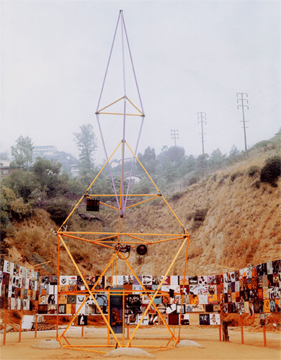
Mark di Suvero, The Peace Tower, 1966. Image and a must read article here
As the article by Greg notices, Suvero's work has an interesting political history, one that could be relevant to the #OWS movement. Yet, is that information, which would be present in a gallery, lost in a public sphere? Why isn't there more information about public art works readily accessible?
Hopefully Richard McCoy's Wikipedia Saves Public Art project really takes off and the information behind these works can become more accessible.
Ben Kinsley

Street With a View. you MUST watch the video, here.
I don't claim that this magical interaction with google street view and a community has an overt function. Yet, this is the first time I have seen a community come together to personalize their interaction with the cold and removed google street view. I hope in the future there are more of these interactions to come.
Carsten Höller: Experience
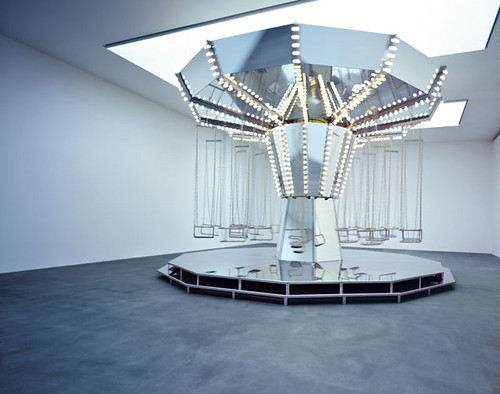
Carsten Höller: Experience at the New Museum. Here. Image from here.
Wouldn't it be an poignant theoretical piece of experiential art to ride a carousel inside a gallery? No.
But what about its phenomenological implications with the use of mirrors!? No.
It is just a fun carousel ride, probably devoid of most of the excitement of an actual carnival. Maybe it will finally give a billionaire the courage to ride a carousel in public by having art theory to back the ride...
Fitting In

taken from This Big City.
With transportation causing most of the world's negative environmental impacts, like green house gases and high oil consumption, why don't we all move into cities?
The population of the United States is roughly 307 million, and the population of NYC is 8.17 million. This means that if everyone in the united states lived in a New York City sized city, we would only need 37 cities to house the USA. We could have super fast trains taking travelers to and from those 37 cities, no cars would be needed. All the funding that went toward highways and roads would go towards buses, trains, and subways. We could easily fund an immaculately clean, efficient, and pleasant subway system.
Our energy consumption would plummet, access to cultural institutions would skyrocket, and our lands might return to a natural order.
How to Feel the News
Photo by Adam Ferguson
After reading an article at the Guardian about war photography, my trials and tribulations of trying to be in the NYC art scene feel so insignificant. Read here. (warning: very disturbing photos)
In terms of cultural production and commitment to the human race, are the goals and affect of these works more important and more effective than that of works in the fine art sphere? Bradford's beautiful collages reference issues of class and urban issues, but do they reference those issues in a productive way or to the right audience? Could these photos of war be considered 'art' and would naming them as such make them more powerful?
Photojournalists are risking their lives or safety so that we can know what is happening around the world, Maybe we don't need another intense performance artist whose masochistic works aim to make us think about bodily harm, pain, and suffering, there is already enough to go around. If artists who are proposing alternatives to capitalism, confronting tyranny, promoting socialism, as many social practice/relational aesthetic artists claim, wouldn't they be better servicing society by being photojournalists, politicians, or social workers? These photos have real artistic merit, but somehow are unwelcome in the gallery scene.
Photographers Tim Hetherington and Chris Hondros were killed earlier this year while documenting the uprising in Libya. Would we have cared about the uprisings without journalists like these? Tweets, facebook events, and amateur photos/videos are crucial, but maybe without artful documentation, would we care as much?
Photographers Tim Hetherington and Chris Hondros were killed earlier this year while documenting the uprising in Libya. Would we have cared about the uprisings without journalists like these? Tweets, facebook events, and amateur photos/videos are crucial, but maybe without artful documentation, would we care as much?
Alfredo Jaar, detail shot of the Rwanda Project

Installation shot, from here
Artists acting as journalists. Alfredo Jaar takes his work a step towards art by making a very aesthetic installation of photographs Rwandans eyes, after the Rwandan Genocide. This moving installation, a combination of photojournalism and art, might be the best of both worlds. To be a good citizen one must know what is happening, know who to vote for, how the stocks are doing, and what is happening in their area. People don't usually go to museums think about the news, but Alfredo Jaar's work could help change that. By making immense and emotional connections to the news, his work counters the commonly overwhelming news field that nourishes disconnect, instead of empathy and understanding.

Fred Wilson, Metalwork, image from here
Nothing to do with photojournalism, but everything to do with bringing political questions into the museum context. Fred Wilson's process of 'Mining the Museum', blurs the line between a history museum and an art museum. His famous installation, Metalwork, juxtaposes ornate silver vessels with slave shackles from the same era and area. Metalwork asks crucial questions about the museum as an institution to produce culture and history. How should a museum show history? Who decides which history to show? In Metalwork, Wilson subverts standard display rules by simply adding a larger context.
What I am suggesting is that art does not have to shy away from being educational and in dialogue with the news. There is no reason why history, politics, journalism, and aesthetic sensibility cannot mix.
Jane's Carousel

image from Wall Street Journal, here. Jane's Carousel website, here.
In DUMBO's Brooklyn Bridge Park, Jane's Carousel is unlike any edition to a park I have ever seen. Jane is an artist, but this seems more in line with urban planning and conservation. Tickets are $2 a ride, which beats the Chicago Ferris Wheel by $4.
I like this weird clash of modern glass architecture designed by French architect, Nouvel, and a refurbished carousel. It seems like a fresh take on how to modernize a park.
I like this weird clash of modern glass architecture designed by French architect, Nouvel, and a refurbished carousel. It seems like a fresh take on how to modernize a park.
Who Produces Culture?

Bob and Roberta Smith, Tate Modern, 2008. more
How can we quantify cultural production? What data is needed to properly compare two institutions' services in the community as well as to the world? I certainly do not believe that attendance and income are the best measures, but they must say something. Justin Bieber's youtube video would be the best (youtube most played), or Avatar would be considered the best movie (highest grossing movies), or Walmart could be quantified as the best store (list of companies by revenue). However, we cannot easily write off this data. Why are these items doing so well? They are operating on a global sphere, and must be appealing to a very accessible, easy, entertaining, and common denominator. They also were very well advertised, well planned, business ventures. But are they the best?
Maybe culture production needs some new metrics behind culture. Who uses/buys the item is one thing, but also what does that institution/artist/event incite outside of itself? What creativity and positive influences ripple out? Do the British feel happier and more fulfilled because of the experiences with the National Health Service as well as the Tate? How is the fulfillment different?
Maybe culture production needs some new metrics behind culture. Who uses/buys the item is one thing, but also what does that institution/artist/event incite outside of itself? What creativity and positive influences ripple out? Do the British feel happier and more fulfilled because of the experiences with the National Health Service as well as the Tate? How is the fulfillment different?

Cedar Tavern, NYC
These questions make me think of Cedar Tavern, which was hang out for many poets and artists, famously the Abstract Expressionists. I am a firm believer in art groups and learning about the New York School really helped confirm that hunch in undergrad. These were a group of artist friends, that passionately talked and debated the merits of different techniques and practices, and together became wildly successful. So, how to we understand Cedar Tavern's role in their influence? Many of their ideas behind Abstract Expressionism were created by informal conversation at this pub.
It seems clear to me that schools are of fundamental importance to culture production. If you aren't engaged at a young age by creativity, expression, and intellectual thought, a visit to the MoMA, most likely will not change that.
It seems clear to me that schools are of fundamental importance to culture production. If you aren't engaged at a young age by creativity, expression, and intellectual thought, a visit to the MoMA, most likely will not change that.
Tauba Auerbach

CMY1, Tauba Auerbach, 2008
Check out a short video interviewing Tauba Auerbach about how beauty can be used as an inviting tool for involvement and interest in the sciences. She talks specifically about her interactive geometric drawing piece for children. Video here
5 Million Dollars for Free
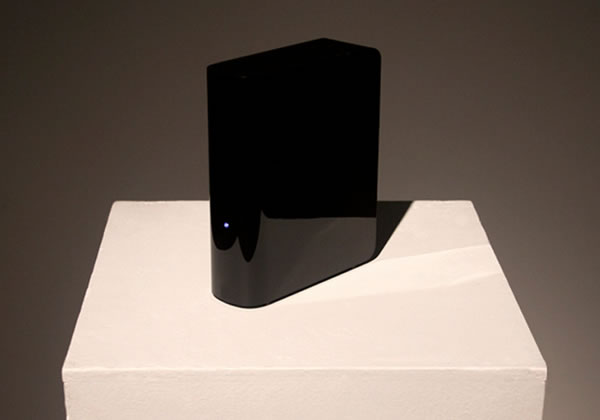
5 Million Dollars 1 Terrabyte, 2011
Income Gap
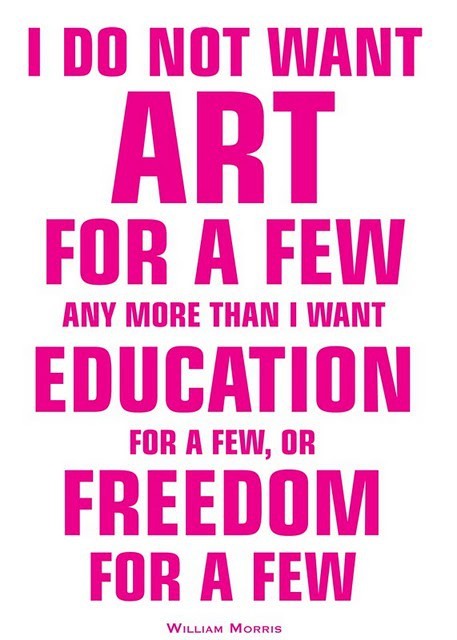
William Morris was an outspoken proponent of the Arts and Crafts Movement and did not believe in artistic genius. Morris instead believed that beauty lay in craftsmanship and that everyone could learn to create beauty and have the ability to come to surround themselves with beautiful objects.

Woman III, by Willem De Kooning sold in 2006 for $137.5 million. As one of the most expensive paintings ever sold, Woman III, represents the huge rejection of Morris' philosophy in the art world today, and also the ever growing gap between the income of the average person, and that of the mega-wealthy, especially in the United States.
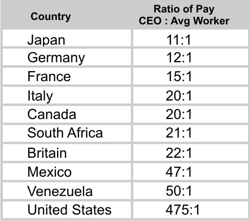

The Internet and Social Change
Definitely watch Clay Shirky's TED talk about his must-read book, Cognitive Surplus: Creativity and Generosity in a Connected Age. He covers crisis mapping, which is an incredible new tool for democracy, which was started in 2007 to document human rights violations in Kenya through crowd sourcing, more here. Sounds like something Syria, Egypt, Libya, and really any country could use.
I was also taken by Shirky's mention of lolcats. He contextualizes lolcats by reminding us that there were pornographic novels printed before academic peer-reviewed journals. We are just scratching the surface of the internet's potential, it makes sense that we see a rise in a lowest common denominator, like porn or lolcats.
What Shirky delves into further in Cognitive Surplus is the drastic difference between passive and interactive media. Lolcats are a step above Jersey Shore because at least the viewer made something instead of passively consuming, we are now all producers of culture. He claims that the amount of time spent creating wikipedia is smaller than the amount of time American's spend watching tv every weekend. That alone is a chilling realization that the internet is truly an untapped resource.
(more books you should read if you are interested in the future of technology here)

Although maybe not as adaptive and generative as Crisis Mapping, Witness seems to be a very legitimate global effort to arm citizens with the tools to have a voice. This trope has gained currency, now that you can upload a video of police brutality, like this one from #OccupyWallStreet, and it can easily get over 500,000 views in a couple of days. The saying "The whole world is watching", seems more true than ever before and organizations like Witness are helping.
Architecture for Humanity utilizes the ability of architects to solve real problems. By spreading architectural designs all over the globe through their Open Architecture Network, an open-source community of architects and designers are working to confront the problems that architecture can solve, for people who couldn't afford it before.
This program is freeing up information that highly educated and skilled designers and architects know and usually charge for. This spreading of architectural solutions to various geographical and political problems is fantastic.
At first I was worried by the notion of a firm in Europe 'solving' a problem for a community in rural Africa. Sound familiar World Bank and IMF? Architecture for Humanity couples the designers with the men and women on the ground, creating a collaboration of information running in both directions to help make the best plans possible.
This program is freeing up information that highly educated and skilled designers and architects know and usually charge for. This spreading of architectural solutions to various geographical and political problems is fantastic.
At first I was worried by the notion of a firm in Europe 'solving' a problem for a community in rural Africa. Sound familiar World Bank and IMF? Architecture for Humanity couples the designers with the men and women on the ground, creating a collaboration of information running in both directions to help make the best plans possible.
Art > Ads
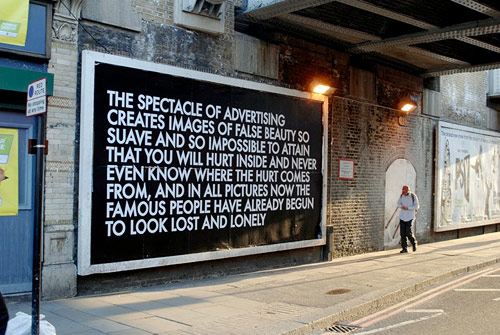
Robert Montgomery from booooooom blog.

Steve Lambert created a program along with Eyebeam and Rhizome to replace online advertising with art works, more.

Felix Gonzalez-Torres, image from here
I am really impressed by these billboard photo pieces by Torres. The beautiful, mute, black and white photos are always displayed with no information provided. This practice puts aesthetic imagery with no marketable qualities into a public sphere in a very nice, subtle manner.

more by Steve Lambert.
Subscribe to:
Posts (Atom)


